If you’ve never heard of beet kvass before, you might be wondering what the heck it is. Or maybe you have heard of it, maybe even been told it tastes like salty beet water. If so, somebody lied to you.
But it’s probably not their fault! It saddens me that so many have had less than stellar introductions to this wonderful lacto-fermented beet drink. How can you make beet kvass taste better if you don’t even know it is possible?
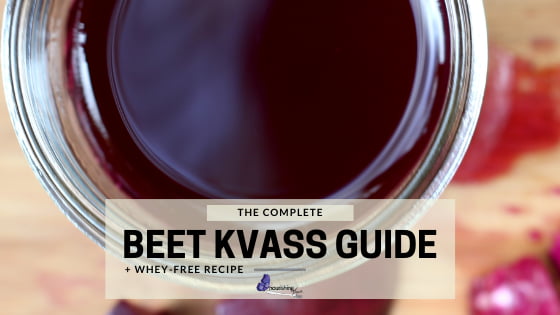
Today you will learn how to make beet kvass without whey, what beet kvass actually is, and why you should drink this thing regularly. I will also share a recipe that tastes nothing like salty beet water, that way you will make beet kvass that you actually want to drink.
Beet kvass is easily one of my family’s favorite ferments. I kid you not. I’m sharing a recipe for plain beet kvass today, but I’ll share the other variations we drink regularly soon.
What do I need to make beet kvass? Do I have to use whey?
To make beet kvass, you will need the freshest beets you can find, good quality salt, and clean water. That’s it! I love simple recipes!
I also highly recommend a fermenting jar with an airlock, such as the Pickl-It, for best results. These jars have an airlock atop a Fido jar, which is a good quality, lead-free Italian glass boasting a truly airtight seal. They allow oxygen to be pushed out of the jar rapidly, and excess CO2 gas to escape. Trapped gases can lead to undesired results such as mold development, excess histamine, off flavors and colors. It can also lead to the occasional exploding jar.
No, you do not have to use whey to make beet kvass. In fact, I highly recommend that you skip the whey in your fruit and vegetable ferments. Leave the whey in your dairy, where it belongs.
I, like many others, first learned of beet kvass in Nourishing Traditions. While I still credit the book for helping me learn about this wonderful world of traditional foods, it is not one I turn to for fermenting advice.
You’ll find that I never use whey for fermenting. For one, different foods have their various strains of bacteria they hang out with. Whey is also unnecessary, and best suited for the dairy it comes from.
I never really got into using whey for ferments because I began this fermenting journey for my son, who had multiple digestive issues and allergies, including dairy. Adding whey did not sound like a good idea for someone allergic to milk proteins, so I had to seek alternatives.
It turns out the alternative, fermenting without whey, is the best way! I also learned quickly from others that fermenting with whey often leads to sub-optimal results. No thanks!
What is Beet Kvass?
Beet kvass is a fermented beet drink. Rather than juicing the beets and directly fermenting the resulting juice, it is more of an infusion where the nutrients from the beets are extracted by the salt water brine.
You can use any type of beet to make beet kvass. I mostly use red beets, which results in a deep purple drink. You can use candy cane beets, which will result in a pink drink. You can also use golden beets, which will result in a milder, light orange drink.
Kvass is a traditional fermented drink from the Eastern Slavic region (Russia, Ukraine, Belarus). It is most commonly made with rye bread, but also made by fermenting other foods such as caraway, beets, etc.
In this region, the sour taste of fermented foods are widely loved, whether it is kvass, sauerkraut, cucumber pickles or fermented dairy.
It is actually kind of ironic that so many people worry about the safety of making fermented foods when it is one of the BEST ways to make food and water safer to consume. Proper fermentation rids food of toxic components and has a low pH that makes it virtually impossible for bad bacteria, yeasts and molds to survive. Some would argue fermenting is safer than many other means of food prep, and there are also studies that support this notion.
Fermentation also increases valuable nutrients, makes them easier for our bodies to absorb and assimilate, and extends the life of foods, which was crucial for getting by between harvests before many of the modern luxuries we have now.
Kvass is considered an elixir, a nourishing medicinal tonic, suitable for many ailments and overall health and well-being.
Why use beets instead of rye?
When we first started on our gut healing journey, we cut out all grains. This includes rye. I considered trying rejuvelac and probably still have the pack of unopened wheat berries hiding somewhere.
I ultimately decided we would forego even fermented grains, such as rye kvass and sourdough, for at least 6 months as it can take some time for the body to repair itself from any damage one might have experienced due to grains. The recipes for making rye kvass also use sugar and tests have shown it can include up to 1% alcohol.
Further research on beets convinced me to try multiple fermented beet recipes, including beet kvass. We did also try raw beets, but they are not as easy to digest as fermented beets are. Nor do they taste as good…
This study highlights the benefits of beet supplementation as:
- increasing nitric oxide (NO), which can help cardiovascular health by:
- preventing and treating hypertension (high blood pressure)
- regulating immune function
- supporting platelet adhesion/blood clotting
- reducing inflammation
- chronic inflammation leads to obesity, cancer, liver and heart disease
- sufficient supplementation of beetroot may work better than synthetic anti-inflammatory medicines such as Ibuprofen
- offering some protection from the toxic effects of chemotherapy
- combating oxidative stress, including from external causes such as radiation
- improving cognitive function, and potentially positively affecting those with dementia/Alzheimer’s disease
While further research is warranted to determine potential treatments with beets/beet components, there is overwhelming evidence that regular beet consumption has health-promoting effects.
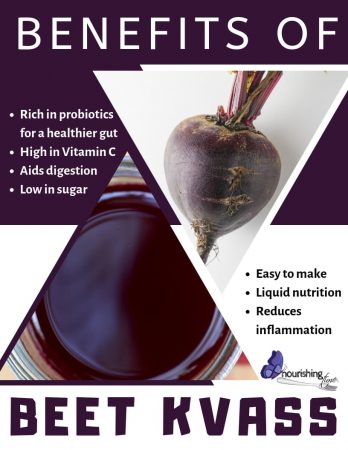
Health Benefits of Beet Kvass
The beet kvass health benefits are plenty. One of the main reasons I decided to try beet kvass again after having yucky results the first couple times was to put an end to my son’s SIBO symptoms and poor sleep.
With the aid of beet kvass and a variety of other fermented foods, we were able to banish all of these negative symptoms and more: painful stomach cramps, alternating diarrhea and constipation, weight loss, abdominal distention, foul “rotten egg” smelling gas (even when he was egg-free!), and malabsorption.
I considered beet kvass an important ferment to detoxify and nourish for the following reasons:
- It is ready to use much quicker than sauerkraut (which I ferment anaerobically for 3 months or more)
- It does not have an overwhelming taste, so it is palatable for little ones and adults alike (it’s easier to get ferments in if they taste good or if the flavor can easily be altered)
- A little bit packs a big punch (it is full of antioxidants and a multitude of vitamins and minerals)
Here are the main benefits of beet kvass, and why you should strongly consider adding it to your family’s diet:
It is full of probiotics
If you’re not already familiar with the many benefits of probiotics and fermented foods, click here to learn more. In a nutshell, probiotics are friendly bacteria that help our bodies function properly. They are tasked with creating and assimilating important vitamins and substances. They can help with a wide variety of digestive issues, which in turn can positively affect skin, hormones, mental state, etc.
It is a great source of vitamin C
I’d be shocked if you haven’t heard of the benefits of vitamin C. It is a vitamin found in many fruits and vegetables and one of the stars in fermented foods. Your body requires more vitamin C than normal during times of stress, like when you are fighting an infection. The vitamin C content in sauerkraut is praised for helping sea voyagers avoid scurvy (read this interesting article for more info on that!).
Adequate vitamin C consumption is important for:
- tissue repair/wound healing
- neurotransmitter production (think dopamine and serotonin, which are important for mood, digestion, and sleep)
- your immune system
- iron absorption
- healthy teeth
You can read more about the importance and benefits of vitamin C by clicking here.
It is a good source of hydrochloric acid (HCl), beneficial for digestion
When my son had raw beets (even if blended in a smoothie) or beet juice, it would color his poop red. Sometimes his pee would even have a light pink tint! These are tell-tale signs of low stomach acid, which can signify poor digestion and absorption. Fermented beets aid digestion so you can assimilate nutrients properly. You won’t have to worry about things coming out the same way they went in.
It is lower in sugar than beet juice
In addition to preserving the shelf life of foods, fermentation also breaks food down, making them lower in sugar and easier to digest. Many people who need gut healing find that they have a low tolerance for sweet things, even natural fruits and vegetables.
Beets are one of the vegetables that can cause issues for someone struggling with low sugar tolerance and/or candida overgrowth. Fermenting beets solved this problem for us, and can probably help you too if that’s a struggle for you.
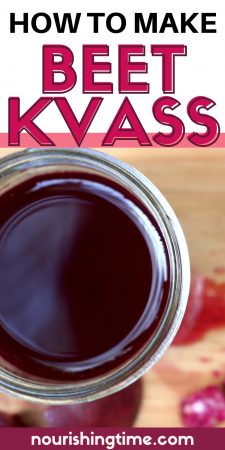
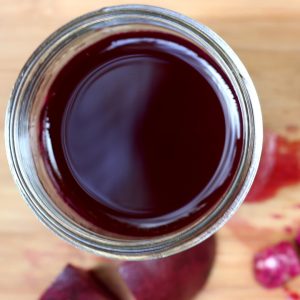
Beet Kvass Recipe Without Whey
Ingredients
- 2 lbs beets (peeled)
- 7 cups brine (approximately)
Brine (2.5g salt per cup of water)
- 18 grams salt
- 7 cups water
Instructions
- Peel your beets
- Cut your beets in big chunks and fill your jar 1/3 full.
- In a pitcher, make your brine
- Fill the fermenting jar to the shoulder with brine (leave about 1-1.5 inches of space, and make more brine if necessary)
- Close the jar and allow to ferment for 2 weeks at room temperature
- Swirl the jar daily to discourage yeast formation on top of your kvass
- Leave in the fridge to ferment further for 2 weeks
- Strain out beets and bottle in swing-top jars
- Discard beets or shred into salads. Do not re-use for another batch of kvass. They are mostly devoid of nutrients, but can provide fiber, flavor and some probiotics in salads/smoothies.
Notes
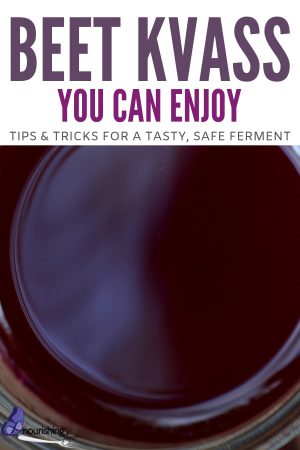
Tips & Tricks for Successful Beet Kvass Fermentation
After troubleshooting many batches of beet kvass, I’ve found that these are the best methods to follow for a mold- and kahm-free final product.
Use the freshest beets you can find
Fermentation is widely used to preserve a harvest, this starts with fresh foods. It should not be an afterthought to make use of veggies that are beginning to spoil. Fresh beets should be hard to the touch. If the skin is beginning to soften, it is not the best idea to make your beet kvass with it.
Peel the skin off your beets
Most people say to leave the skin on for fermentation, but I find that this greatly affects the chances of having a successful ferment, and can also affect flavor. I am not one to skim off mold or kahm yeast, so I like my ferments to turn out well because otherwise they get tossed. The appropriate bacteria is available all throughout the vegetable, so you do not need the skin.
Use an airlock
Airlocks on a truly anaerobic vessel locks out oxygen, which is unwanted during fermentation. Oxygen increases your chances of toxic yeasts and molds growing on your ferment. An airlock also allows the gases that form during fermentation to escape without having to “burp” a jar, which allows oxygen to flood into the ferment. CO2 build-up can be blamed for jars exploding during fermentation, so allowing it to escape as it is formed is very beneficial. Beet kvass tends not to create as much gases as some ferments, but the first several days tend to be quite active and bubbly. You can read more about why I ferment anaerobically here.
Wash your jar directly before fermenting
Yes, even if you’re sure your jar is clean.
Most people have their jars already clean and dry and just pick them up and go straight to the fermenting step. This is generally OK. I’m not saying we need to fear the wild bacteria and yeasts, however when we are fermenting we want to nurture specific strains. And those strains are particular to the foods that we are fermenting.
I have found that for some ferments, washing the jar directly before use greatly decreases the possibility of having negative results, like kahm yeast for example. Beet kvass is definitely one of those ferments, and I like to take every precaution I can to ensure successful results. In fact, since I started doing these things I’m sharing, I’ve never had a batch of beet kvass go bad!
You can wash the jar, rinse very well, and use wet (do a final rinse with filtered water if you are concerned about tap water residue, which I personally don’t worry about).
Swirl your jar daily (or even more, if you remember to)
Beet kvass is what I call a “finicky” ferment. It is one of the easiest to make, yet one of the ferments people complain about having bad results with most often. Since I started swirling my jar of beet kvass daily, I have not had a batch go bad. Friends that I’ve told to do this trick have also had great results (and some of them do not even use an airlock!). If I happen to walk past the jar of beet kvass more often during the day, I’ll swirl it more often. It won’t harm your ferment!
I believe this works because it distributes the lactic-acid bacteria growing throughout the jar to quickly kill any yeast/mold trying to grow on the surface of the ferment.
Do not re-use the spent beets to make more batches
I can understand wanting to be thrifty and eliminating food waste. However, once you’ve fermented the beets to make beet kvass, they are very low in nutrients. I would not use them for future ferments despite popular opinion. The sugars and nutrients in fresh beets provide fuel for proper fermentation. Using the spent beet chunks in salads, smoothies, or to bulk up gravies, etc. would be a better idea. Use the freshest beets you can find each time you are making a new batch of beet kvass.
Do start a new batch once you’ve used up half of your beet kvass
This is a great fermented beverage to keep on hand at all times. Since it takes several weeks to be ready, I like to start a new batch once I’m about half way through the current batch. That way, as soon as I’m done with the current batch, the new batch is just about ready.
Frequently Asked Questions (FAQ)
Once fermentation is complete, beet kvass will stay good for a long time. We generally use ours up within a month or two, and keep making new batches on rotation so we have more ready as soon as the current batch is done.
A starter culture is not necessary when making beet kvass. If you choose to use one, it should be a veggie starter culture instead of brine from an already completed ferment. For that reason, I do not use a previous batch to start the current batch of beet kvass. It can help deter spoilage, but it is also “cheating” in a sense and doesn’t allow the ferment to develop through all its stages properly.
Yes, definitely! Fermented beverages are very easy on the digestive system and don’t require much “work” on your body’s part due to low fiber content. Additionally, beet kvass is full of important vitamins and minerals you might be deficient in. It is easy to digest and has enzymes and probiotics to help fight harmful bacteria and yeasts that contribute to your digestive issues. Beet kvass also contains an abundance of antioxidants that help support your immune system.
That will greatly depend on what other fermented foods you are having. Consuming 4oz once or twice a day is a great goal. We prefer to drink right before bed, and sometimes upon waking or 10-15 mins before dinner. There have been times we crave more and drink a whole glass, but for the most part we try to include a variety of fermented foods and beverages throughout the day. For more detailed information to decide how much you should have per day, click here.
I do not personally believe it is safe to skim mold off of a ferment and go on to consume it. Mold travels throughout, even if you cannot see it. Mold also creates toxins. It may be kahm if it is thin with bubbly patches. Mold generally results in thicker patches that look furry. Either way it will affect the taste of your ferment, and mold definitely affects the health. In cases of mold, I would definitely toss. I also toss if kahm yeast forms but kahm is generally thought to be safe and many choose to skim it off and consume as normal.
This generally means that it has been exposed to too much oxygen and an oxidation reaction is occurring. This is not ideal and nutrients are lost during the process.


N
Sunday 12th of January 2025
My kvass tastes really good, but it doesn't taste fizzy at all. I've never had beet kvass before so don't exactly know what to expect. I had followed another recipe (and just found your awesome post!), and I left it out to ferment a little over a week, and when I opened the jar, it popped. So does that mean it worked? Thanks!
Liz
Thursday 17th of October 2024
I’m a bit confused A 1% solution is 1gm / 100 mls so in 1 cup which is nearly 250 mls 2.5 gms gives a1% solution. But you say you use a 2 % solution so your recipie should read 5gm. Salt/1cup. And for 7 cups shouldn’t it be 35 gms salt?
Delinda
Monday 14th of October 2024
Can I use frozen beets to make Kvass?
hana
Wednesday 22nd of February 2023
Hi
I ferment my beet kvass in bromioli rocco jar with an air lock.
everything seems fine. it was ready less than a week.
but after straining and storing in the fridge, a day or 2 later its not this dark red anymore, has a brown tinge to it.
why is this happening?
can i still drink it?
how is it oxidising?
Krystal Batterton
Sunday 17th of July 2022
Hi there! I’ve always bought beet kvass and it was earthy and fizzy but I decided to finally make it on my own because it’s not cheap to buy ? I followed the recipe exactly and used a mason jar with the silicone nipple so I didn’t have to burp it and I tried it today and it tastes like salty beet water. What did I do wrong ?
Jo
Thursday 21st of July 2022
@Krystal B., It sounds like it hasn't fermented. :( I am not very familiar with the silicone nipples, have you fermented anything with them before? I'd first think maybe it is cold where you are and it needed a warmer environment, or the beets weren't very good. Were they very fresh beets?